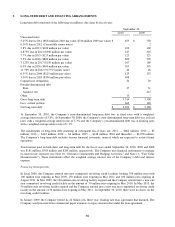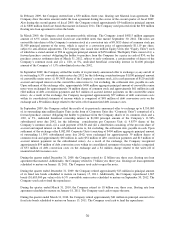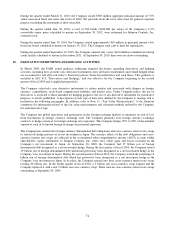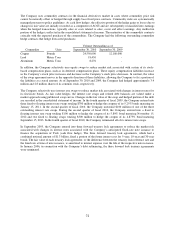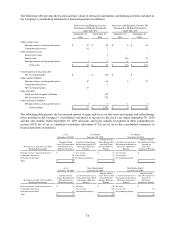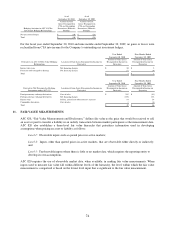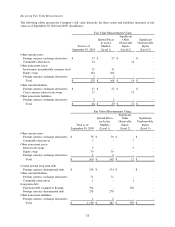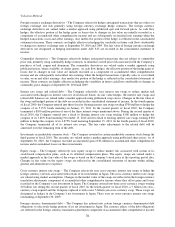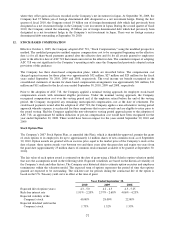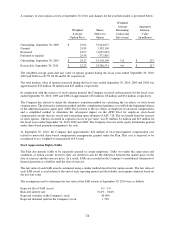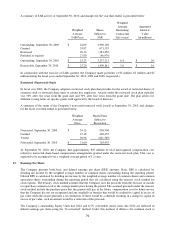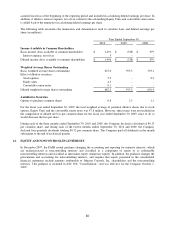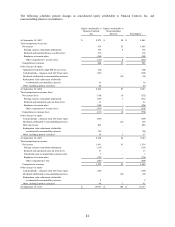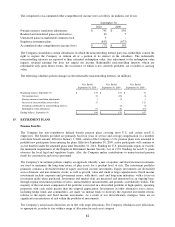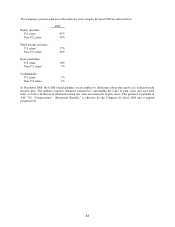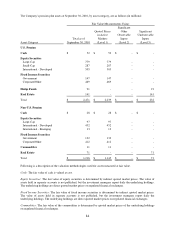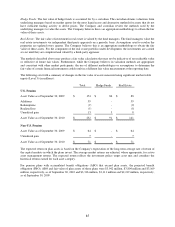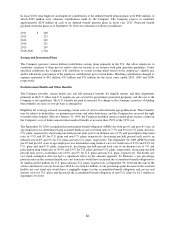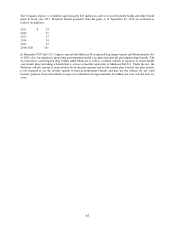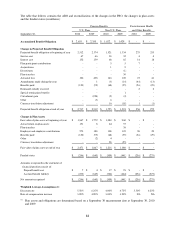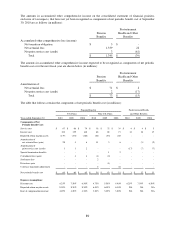Johnson Controls 2010 Annual Report Download - page 79
Download and view the complete annual report
Please find page 79 of the 2010 Johnson Controls annual report below. You can navigate through the pages in the report by either clicking on the pages listed below, or by using the keyword search tool below to find specific information within the annual report.
79
A summary of SAR activity at September 30, 2010, and changes for the year then ended, is presented below:
Weighted
Average
Aggregate
Weighted
Shares
Remaining
Intrinsic
Average
Subject to
Contractual
Value
SAR Price
SAR
Life (years)
(in millions)
Outstanding, September 30, 2009
$
24.69
2,996,198
Granted
24.87
671,335
Exercised
20.13
(383,450)
Forfeited or expired
27.80
(46,970)
Outstanding, September 30, 2010
$
25.23
3,237,113
6.4
$
20
Exercisable, September 30, 2010
$
23.20
1,909,881
5.0
$
16
In conjunction with the exercise of SARs granted, the Company made payments of $3 million, $2 million and $5
million during the fiscal years ended September 30, 2010, 2009 and 2008, respectively.
Restricted (Nonvested) Stock
In fiscal year 2002, the Company adopted a restricted stock plan that provides for the award of restricted shares of
common stock or restricted share units to certain key employees. Awards under the restricted stock plan typically
vest 50% after two years from the grant date and 50% after four years from the grant date. The plan allows for
different vesting terms on specific grants with approval by the board of directors.
A summary of the status of the Company’s nonvested restricted stock awards at September 30, 2010, and changes
for the fiscal year then ended, is presented below:
Weighted
Shares/Units
Average
Subject to
Price
Restriction
Nonvested, September 30, 2009
$
34.13
956,500
Granted
25.18
440,455
Vested
30.96
(631,500)
Nonvested, September 30, 2010
$
31.60
765,455
At September 30, 2010, the Company had approximately $10 million of total unrecognized compensation cost
related to nonvested share-based compensation arrangements granted under the restricted stock plan. That cost is
expected to be recognized over a weighted-average period of 1.2 years.
13. Earnings Per Share
The Company presents both basic and diluted earnings per share (EPS) amounts. Basic EPS is calculated by
dividing net income by the weighted average number of common shares outstanding during the reporting period.
Diluted EPS is calculated by dividing net income by the weighted average number of common shares and common
equivalent shares outstanding during the reporting period that are calculated using the treasury stock method for
stock options. The treasury stock method assumes that the Company uses the proceeds from the exercise of awards
to repurchase common stock at the average market price during the period. The assumed proceeds under the treasury
stock method include the purchase price that the grantee will pay in the future, compensation cost for future service
that the Company has not yet recognized and any windfall tax benefits that would be credited to capital in excess of
par value when the award generates a tax deduction. If there would be a shortfall resulting in a charge to capital in
excess of par value, such an amount would be a reduction of the proceeds.
The Company’s outstanding Equity Units due 2042 and 6.5% convertible senior notes due 2012 are reflected in
diluted earnings per share using the ―if-converted‖ method. Under this method, if dilutive, the common stock is


